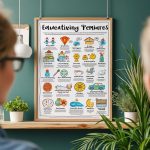In the words of Albert Einstein, “Creativity is intelligence having fun.” As TESOL teachers, fostering creativity in the classroom opens up new doors for critical thinking, testing, and learning. Traditional teaching methods, while valuable, can sometimes limit the potential of language learners. By integrating creative approaches and modern technology, students can engage in a more dynamic, enjoyable, and effective learning experience.
In this article, we’ll explore a selection of educational applications designed to boost creativity, stimulate critical thinking, and revolutionize how students test and learn English. Let’s dive into these innovative tools and discover how they can bring intelligence to life through fun, interactive learning!
1. Kahoot! – Turning Quizzes into Fun Games
Kahoot! transforms traditional testing into an engaging, game-based activity. This app allows teachers to create custom quizzes and turn them into fun, competitive challenges where students answer questions in real-time. The dynamic platform is perfect for reinforcing grammar, vocabulary, and comprehension skills.
Why It Works:
Kahoot! encourages students to think critically and respond quickly. By gamifying the testing process, learners feel motivated and energized to participate, which helps them retain information more effectively.
2. Minecraft: Education Edition – Building Language Skills Through Exploration
One of the most creative platforms available, Minecraft: Education Edition brings virtual world-building into the classroom. Students can collaborate to create virtual environments, solve challenges, and use English to communicate and complete tasks.
Why It Works:
Minecraft fosters critical thinking and teamwork. As students work together to solve problems and build their digital worlds, they practice language skills in real-life scenarios, which deepens their understanding and fluency.
3. Storybird – Inspiring Creative Writing and Storytelling
Storybird is an excellent platform for nurturing students’ creativity in writing. The app allows users to create stories, poems, and picture books based on inspiring artwork. Teachers can assign writing projects or let students express themselves freely.
Why It Works:
Storybird taps into students’ imaginations, encouraging them to write creatively while improving their grammar and sentence structure. The visual stimuli provided by the artwork inspire unique stories, helping students explore language in an engaging way.
4. Flipgrid – Engaging Video Discussions
Flipgrid gives students the opportunity to create video responses to discussion prompts, providing a dynamic platform for practicing speaking and listening skills. Teachers can post questions or topics, and students respond via short videos, making it a fun way to engage in oral communication.
Why It Works:
Flipgrid turns the traditional discussion format into a creative exercise. Students use video tools to express their thoughts, while teachers can assess pronunciation, fluency, and critical thinking. It’s an excellent way to encourage shy students to participate more actively.
5. Plickers – Instant Classroom Assessments
Plickers is a simple yet powerful app that allows teachers to conduct real-time assessments using printed QR codes. Teachers ask a question, and students hold up a card with their answer. The teacher scans the room using a smartphone, instantly recording the students’ responses.
Why It Works:
This tool transforms testing into a creative, fast-paced activity. Plickers encourages critical thinking and helps students demonstrate their understanding without the pressure of traditional tests. The instant feedback helps teachers adjust lessons to address areas of improvement.
6. Canva – Visual Learning and Presentation Creation
Canva is a design tool that allows students to create stunning visual presentations, posters, infographics, and more. It offers a vast library of templates and graphics, making it easy for students to express ideas visually while improving their English writing skills.
Why It Works:
Visual learning aids in comprehension, and Canva lets students pair language with design to present ideas creatively. Whether they’re creating a digital poster about environmental issues or presenting a project, Canva enables learners to explore different ways to communicate their thoughts.
7. Brainscape – Smart Flashcards for Vocabulary Mastery
Brainscape is a flashcard app designed to optimize memory retention. Using spaced repetition technology, Brainscape helps students learn vocabulary at their own pace, with customized intervals for review based on performance.
Why It Works:
Brainscape makes vocabulary practice creative and adaptive. By using scientifically proven methods for learning retention, it allows students to master new words while testing their recall, fostering both language skills and memory.
8. Explain Everything – Interactive Whiteboard
Explain Everything is an interactive digital whiteboard app that allows teachers and students to collaborate in real time. It’s perfect for creating mind maps, diagrams, and visual explanations of complex topics, helping learners grasp difficult concepts more easily.
Why It Works:
This app promotes active learning and collaboration. Teachers can use it to break down lessons into visual steps, while students can use the platform to create their own presentations, improving both their language skills and their understanding of new ideas.
9. ThingLink – Interactive Multimedia Projects
ThingLink lets students create interactive images, infographics, and videos by embedding links, audio, and text. Students can enhance photos and presentations with clickable points that provide additional information, turning static images into dynamic learning tools.
Why It Works:
This platform encourages students to think critically about how to present and organize information creatively. It helps learners make connections between ideas and gives them a hands-on, multimedia approach to presenting what they’ve learned.
10. Padlet – Collaborative Digital Wall
Padlet is a collaborative tool where students can create digital walls to post text, images, and videos. This makes it ideal for brainstorming sessions, class discussions, and group projects.
Why It Works:
Padlet promotes collaboration and creativity, allowing students to contribute to a shared platform. It’s a visually engaging way to organize ideas, and the interactive nature of the tool encourages students to express themselves in different media formats.
Conclusion: Creativity Meets Intelligence in TESOL Classrooms
Creative thinking is an essential skill for the 21st century, and as TESOL teachers, we have the unique opportunity to nurture it through innovative teaching strategies. The educational apps discussed in this article offer exciting new ways for students to practice language, collaborate with peers, and engage in critical thinking.
By integrating these tools into your classroom, you can transform traditional language lessons into creative, intelligent, and fun experiences. After all, creativity is intelligence having fun—so why not bring that fun into your TESOL teaching practice?
Introduce your students to new ways of thinking, testing, and learning with these educational apps, and watch as their confidence, creativity, and critical thinking skills soar!



